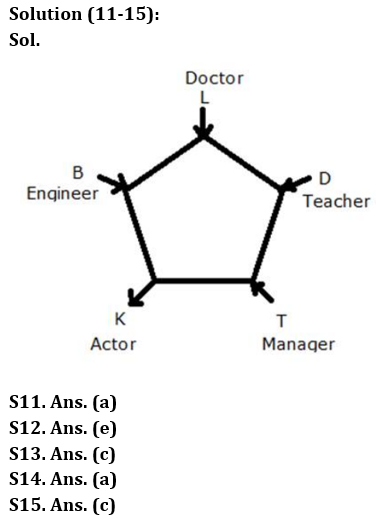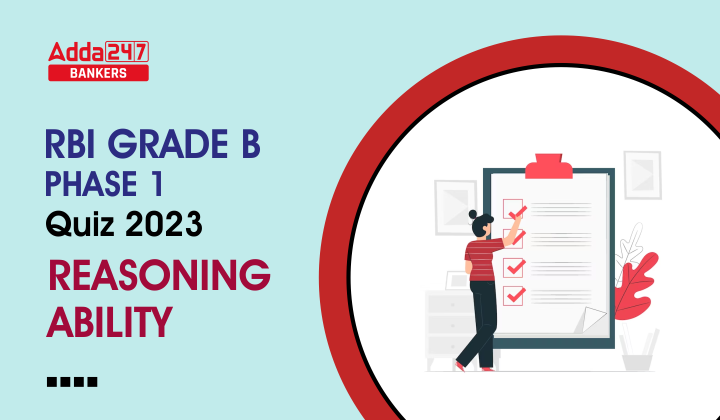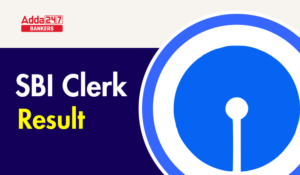Direction (1-5): Following questions are based on the five three-digit numbers given below:
437 341 669 492 136
Q1. If the first and second digits of each number are interchanged, then multiply the second digit of the largest number with third digit of the smallest number.
(a) 36
(b) 24
(c) 20
(d) 32
(e) 28
Q2. If all the digits of every number are added within the number, then which number’s sum of digits will be smallest?
(a) 437
(b) 341
(c) 669
(d) 492
(e) 136
Q3. If the first digit of every number is removed, how many numbers will be divisible by 3?
(a) One
(b) Two
(c) Three
(d) More than three
(e) None
Q4. If the digits of all the numbers are arranged in ascending order within the number from left to right, which will be the third largest number?
(a) 437
(b) 341
(c) 669
(d) 492
(e) 136
Q5. What will be the resultant, if the second digit of the highest number is divided by the second digit of the lowest number?
(a) 3
(b) 2
(c) 1
(d) 5
(e) None of the above
Direction (6-10): Following questions are based on the alphanumeric-symbol series given below:
7 H β 5 % T I M 6 $ E 8 G 3 S N @ A # C D 4 8 U & D
Q6. If all the numbers, vowels and the symbol ‘&’ is removed from the above arrangement then which of the following will be the eighth element from the left end?
(a) @
(b) G
(c) N
(d) S
(e) None of these
Q7. If the first fifteen elements in the above sequence are written in reverse order then which of the following will be the sixteenth element from the right end?
(a) N
(b) 7
(c) %
(d) T
(e) None of these
Q8. If all the letters are changed to their next letter according to the alphabetical series, then which of the following will be the seventh to the right of the tenth element from the left end?
(a) T
(b) D
(c) B
(d) @
(e) None of these
Q9. How many such numbers are there in the above arrangement each of which is immediately followed by a symbol and also immediately preceded by a letter?
(a) Three
(b) Two
(c) One
(d) Four
(e) None of these
Q10. Four among the following five are same in a certain way according their arrangement in the series and forms a group. Find the one that does not belong to the group?
(a) 5%7
(b) 6$T
(c) 8G6
(d) SNA
(e) 8UC
Direction (11-15): Read the following information carefully to answer the questions based on it.
Five persons B, L, T, K and D are sitting around a pentagon shaped table (on each of the corner), not necessarily in the same order. Some of them are facing towards the centre while others are facing away from the centre. The profession of each one of them is different viz., doctor, engineer, teacher, manager and actor, not necessarily in the same order.
D who is not an actor and B who is an engineer, faces the same direction. B sits second to the right of the teacher. K is an immediate neighbour of T who is facing towards the centre. T is not sitting second to the right of L. D sits second to the left of K who faces away from the centre. D sits exactly between the doctor and the manager. T is not the doctor. The engineer sits second to the right of D.
Q11. Who among the following is the actor?
(a) K
(b) T
(c) L
(d) Either K or L
(e) None of these
Q12. Four of the following five are alike in a certain way based on the given arrangement and so form a group. Who among the following does not belong to that group?
(a) Manager
(b) B
(c) Teacher
(d) L
(e) Actor
Q13. Who sits just to the left of L?
(a) B
(b) T
(c) D
(d) K
(e) None of these
Q14. How many persons sit between the teacher and T, when counted from the left of the teacher?
(a) None
(b) One
(c) Two
(d) Three
(e) None of these
Q15. Which of the following combination is not correct?
(a) K-Actor
(b) T-Manager
(c) L-Manager
(d) D-Teacher
(e) B-Engineer
Solutions
Solutions (1-5):
S1. Ans. (b)
Sol. Given Series – 437 341 669 492 136
After operation – 347 431 669 942 316
Second digit of the largest number – 4 (942)
Third digit of the smallest number – 6 (316)
So, required multiplication – 4 x 6 – 24
S2. Ans. (b)
Sol. Given Series – 437 341 669 492 136
Sum – 14 8 21 15 10
After adding all the digits of every number, we find that 341’s sum is be smallest.
S3. Ans. (b)
Sol. Given Series – 437 341 669 492 136
After removing first number – 37 41 69 92 36
So, there are two numbers (69, 36) which are divisible by 3.
S4. Ans. (d)
Sol. Given Series – 437 341 669 492 136
After operation – 347 134 669 249 136
So, third largest number – 492
S5. Ans. (b)
Sol. Given Series – 437 341 669 492 136
Second digit of the highest number – 6
Second digit of the lowest number – 3
So, required division – 2
Solution (6-10):
S6. Ans. (d)
Sol. Given Series – 7 H β 5 % T I M 6 $ E 8 G 3 S N @ A # C D 4 8 U & D
After dropping – H β % T M $ G S N @ # C D D
Therefore, option (d) is correct.
S7. Ans. (c)
Sol. Given Series – 7 H β 5 % T I M 6 $ E 8 G 3 S N @ A # C D 4 8 U & D
Required reversal – S 3 G 8 E $ 6 M I T % 5 β H 7 N @ A # C D 4 8 U & D
Therefore, option (c) is the correct answer.
S8. Ans. (d)
Sol. Given Series – 7 H β 5 % T I M 6 $ E 8 G 3 S N @ A # C D 4 8 U & D
After changing – 7 I β 5 % U J N 6 $ F 8 H 3 T O @ B # D E 4 8 V & E
Therefore, option (d) is the correct answer.
S9. Ans. (c)
Sol. Given Series – 7 H β 5 % T I M 6 $ E 8 G 3 S N @ A # C D 4 8 U & D
Therefore, option (c) is the correct answer.
S10. Ans. (d)
Sol. Given Series – 7 H β 5 % T I M 6 $ E 8 G 3 S N @ A # C D 4 8 U & D
Therefore, option (d) is the correct answer.






 GA Capsule for SBI Clerk Mains 2025, Dow...
GA Capsule for SBI Clerk Mains 2025, Dow...
 The Hindu Review October 2022: Download ...
The Hindu Review October 2022: Download ...
 SBI Clerk Prelims Result 2025 Out, Direc...
SBI Clerk Prelims Result 2025 Out, Direc...







